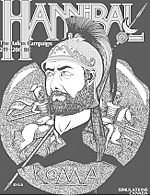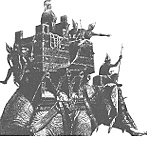
Introduction
Hannibal: The Italian Campaign, 218-206 BC is a game type simulation of the Carthaginian general’s campaign in Italy during the Second Punic War.
Players 2
Period Ancients
Scale Strategic Turn one year, broken up into Summer and Winter segments
Map 40 kilometers per hex
Unit legions and armies
Components
Box generic plastic tray with cover
Map 27"x22" unmounted on thick stock
Rules one 8 page standard sized (only 5 pages of actual rules)
Counters 200 die-cut and backprinted
Counter Manifest
75 Roman (red)
25 Roman (dark brown)
36 Carthaginian (blue)
4 Carthaginian (dark blue)
39 Allied (light blue)
11 Gaul (grey)
10 Game markers and randomizer numbers (grey)
SimCan says:
“Hannibal is a medium complexity strategic study… Players must face the same decisions that confronted Hannibal and the Leaders of Rome. Hannibal must survive year after year in hostile territory. Roman armies must face and hold off a powerful and determined foe. Field combat, sieges, siege combat, recruitment and Roman elections are all taken into account.”
The Reviewers say:
“Peter Hollinger has designed a game faithful to the geography and strategic situation. One has an excellent frame work for creating this epic struggle. Unfortunately, my own best strategy for the Carthaginians leads to unexciting play. Overall, Hannibal has a good basis, but will still profit from tinkering.” --Peter Hatton in F&M 43.
“Unfortunately, [this] attempt is a failure…the most serious error on the map has to be the terrain. Where are the Alps? Movement in this game has got a serious problem…major developmental flaws in the rules. So save your $20.” --David Cook in S&T 95.
 Comments
Comments
The first thing I noticed about this game are the counters, which are hard to read with their tiny icons. The map is bland, and the design does not exude any panache. We do get some interesting rules like Roman elections, elephants, Gauls, and special Carthaginian reinforcements. Separate combat tables cover siege and field combat. Victory points are awarded to the Carthaginian player for province control, city control, killing Roman foot troops, and special VP’s for Capua and Tarentum. The old SPI game Punic Wars has more appeal, and Avalon Hill’s Hannibal: Rome versus Carthage sets the standard for this period in history. There may be a good game buried in Hannibal somewhere, but you’re going to have to find it.
Collectors Notes
Being a design on an Ancients topic, Hannibal will get some notice, but won’t command a high price. Boone quotes low, high and average prices of 4/36/14.86 at auction and 10/20/15.00 for sale.
Errata & Clarifications
The Allied/Gaulish Recruitment Schedule was also intended to be used as the Elephant Attrition Table, but was mislabeled. Use the results of the schedule as indicated by a die roll to determine the step losses for Elephant Attrition. When transferring the names of the leaders from the test copies to the counter format to be typeset, an error was made. The Carthaginian leader Hamil should have been labeled Mago. Hamilcar did not participate in the depicted portion of the 2nd Punic War. Oh yes, due to a mixup with the artist (our fault, not his) [sic] the dates covered by the game are incorrect on the rule book cover. 218 - 206 BC, as used throughout the rules book and scenarios, is correct.
Steve Newberg says:
This was one of the designs the late Peter Hollinger did while working for us in the early 80s. In development, which I did, the two concepts that struck me as making the game unique were the leadership rotation system used to reflect the Roman political situation, and the movement system, which had to be stretched to allow historical actions for the time scale, but not allow things to get unreal, a problem with a lot of Hannibal games.
Back to Simulacrum Vol. 3 No. 2 Table of Contents
Back to Simulacrum List of Issues
Back to MagWeb Master Magazine List
© Copyright 2001 by Steambubble Graphics
This article appears in MagWeb (Magazine Web) on the Internet World Wide Web. Other military history articles and gaming articles are available at http://www.magweb.com